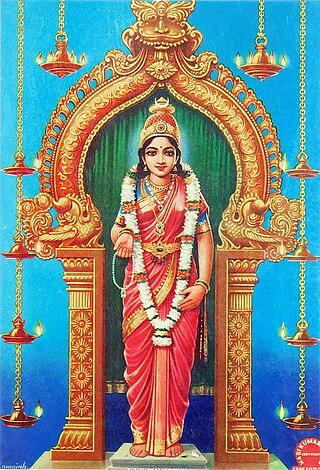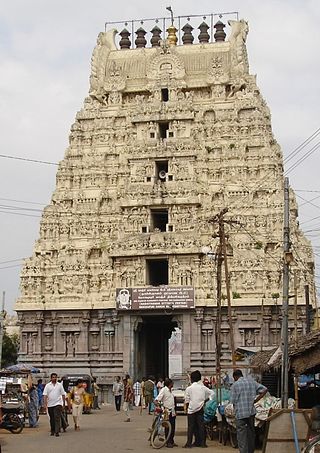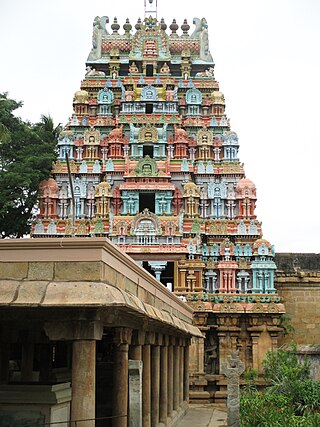
Trimbakeshwar Shiva Temple is an ancient Hindu temple in the town of Trimbak, in the Trimbakeshwar tehsil in the Nashik District of Maharashtra, India, 28 km from the city of Nashik and 40 km from Nashik road. It is dedicated to the Hindu god Shiva and is one of the twelve jyotirlingas where the Hindu genealogy registers at Trimbakeshwar, Maharashtra are kept. The origin of the sacred Godavari River is near Trimbak.

The ChottanikkaraDevi Temple is a temple dedicated to the Hindu mother goddess Bhagavati Lakshmi. She is believed to be residing in Chottanikkara (Mahalakshmi) along with her Husband Maha Vishnu. The main deity is also considered as Lakshmi Narayana according to the temple legend. The temple is Classified one among the 108 Abhimana Kshethram of Vaishnavate tradition. The temple is located at Chottanikkara, a southern suburb of the city of Kochi in Ernakulam district, in the state of Kerala, India and is one of the most popular temples in the state.

Devi Kanya Kumari is a manifestation of the Hindu goddess Mahadevi in the form of an adolescent girl. She is variously described by various traditions of Hinduism to either be a form of Parvati or Lakshmi. She is also worshipped as an incarnation of the goddess Bhadrakali by Shaktas, and is known by several names such as Shrī Bāla Bhadra, Shrī Bāla, Kanya Devi, and Devi Kumari.

Amrithakadeeswarar Abhirami Temple (also called Abhirami temple is a Hindu temple dedicated to Shiva in his manifestation as Kalantaka and his wife Parvati as Abhirami. There is a Shrine for Maha Vishnu as Amrithanarayana and his consort Mahalakshmi as Amrithavalli. It is located in Thirukkadaiyur, 21 km East of Mayiladuthurai, Tamil Nadu in India. This temple is associated with the legend of Shiva saving his young devotee, Markendeya from death, and the tale of a saint, Abirami Pattar a devotee of the presiding goddess.

The Kamakshi Amman Temple, also known as Kamakoti Nayaki Kovil, is a Hindu temple dedicated to the goddess Kamakshi, one of the highest aspects of Adi Parashakti, the supreme goddess in Shaktism. The temple is located in the historic city of Kanchipuram, near Chennai, India.

Subramanya is a village located in Kadaba Taluk in Dakshina Kannada, India. The Kukke Subrahmanya Temple is located here. It is about 105 kilometres (65 mi) from Mangalore, connected by train and road. It was originally named "Kukke Pattana".

Thirumandhamkunnu Temple is a historically significant Hindu temple in Angadipuram, which was the capital of Valluvanad Rajavamsham, in Malappuram district, Kerala state, South India. The temple deity, Thirumandhamkunnil amma, was the paradevatha of the kings of Valluvanad, the local feudal kings ruled the area in the Middle Ages. The Nair warriors of Valluvanad king set out from this temple to Thirunavaya, to participate in the famous Mamankam festival. A memorial structure called the chaver thara can be found in front of the main entrance of the Thirumanthamkunnu Temple.

Jambukeswarar Temple, Thiruvanaikaval is a temple of Shiva in Tiruchirapalli district, in the state of Tamil Nadu, India. It is one of the five major Shiva Temples of Tamil Nadu representing the Mahābhūta or five elements; this temple represents the element of water, or neer in Tamil. The sanctum of Jambukeswara has an underground stream.

Akhilandeshwari is one of the main forms of the Hindu Goddess Adi Parashakti. The famous abode of Akhilandeshwari is the Jambukeswarar Temple in Thiruvanaikaval. She is also revered collectively with the goddesses Meenakshi and Kamakshi, forming the Trishakti triad, the most powerful goddesses in Shaktism. The goddess’s name is split into three components. “Akhila” means the universe, “Anda” means cosmic egg, and “Ishwari” means the divine mother. Therefore, Goddess, the divine mother who protects the entire universe in her womb, is known as “Akhilandeshwari”. Akhilandeshwari is the presiding deity in the Jambukeswarar Temple in Thiruvanaikaval along with her consort Jambukeswarar, who is an avatar of Shiva.

The Vilwadrinatha Temple is a Hindu temple in Thiruvilwamala, a town in the city of Thrissur, Kerala, India. The principal deities are Rama, the seventh incarnation of the god Vishnu, and his brother, Lakshmana. It figures among the Abhimana Kshetrams in Vaishnavite traditions. This is one of the four major Rama temples in Kerala — the other three are in Thriprayar, Kadavallur, and Thiruvangad. The temple houses an idol of Lakshmana, which is rare in India. Vilwadrinatha Temple is located in the centre of the community of Thiruvilwamala, atop a 100-foot-high hillock. Visible from the temple is Bharathappuzha, the second-largest river in Kerala, which flows past the temple's northern side from around 3 kilometres away.

The Shree Vajreshwari Yogini Devi Mandir is a Hindu temple dedicated to the goddess Vajreshwari, located in the town Vajreshwari, 75 km away from Mumbai. The town, earlier known as Vadvali, was renamed Vajreshwari in honour of the presiding deity of the temple.
Nandeeswarar Temple is located in Adambakkam in Chennai, Tamilnadu, India. It is close to St. Thomas Mount suburban railway station. The temple has two entrances one in the east, and another in the south. There is a tank situated outside the southern entrance, though not in use.

Uthirakosamangai, also known as Mangalanatha Swamy temple, is a Shiva temple situated near Ramanathapuram in the Ramanathapuram district of Tamil Nadu. Uthirakosamangai temple is located on an area of about 20 acres.
Spatika Lingam or Crystal Lingam is a type of Lingam made from quartz. Spatika Lingam is called sphatika Sivalingam, ,, . Sphatikam in Sanskrit means "made of crystal, crystalline", referring to quartz and alum.

The Mangadu Kamakshi Amman Temple is a famous pilgrim destination Hindu temple dedicated to goddess Parvathi, located in Mangadu, a suburb of Chennai, India. The term Mangadu means "Mango Forests or Mango Groves" and as the term implies this must have been a thickly wooded Mango groove in times of yore.
Chennai Om Sri Skandashramam is a Hindu temple dedicated to the deity Murugan in Chennai, India. It is located at Selaiyur, Tambaram, a southern neighbourhood of Chennai. The temple is known of its huge idols of several deities, including Kamala Siddhi Vinayakar, Panchamukha Heramba Ganapathy, Dattatreya, Panchamukha Hanuman, Shaniswara, Ayyapan, goddess Ashtadashabhuja Durga Parameswari, Sarabeswara, goddess Prathiyankira, goddess Bhuvaneshwari, Swaminathaswamy, Sudarshanachakathalwar, Lakshmi Narasimhar, Maha Sahasralingamurthy, Nandikeswarar, goddess Annapurani and Chakra Poorna Maha Meru. There is also an idol of Saint Sathguru Santhananda Swamigal, who built the temple.

Nilathingal Thundam Perumal temple is a Hindu temple dedicated to Vishnu, located in Kanchipuram in the state of Tamil Nadu, India. The temple is located in a shrine in Ekambareswarar Temple, the largest temple in the town of Kanchipuram, located in the northern part of the town. The temple gopuram is 59 m tall, which is one of the tallest gopurams in India.

Sri Ramalinga Chowdeshwari Amman, also known as Sowdeshwari, is a Hindu folk deity, regarded by adherents to be a regional form of either Mahadevi or Parvati. She is also called as "Renuga devi" considered to be the Kuladevata of the Devanga people.
Nagesvarar Temple is a Hindu temple dedicated to the deity Shiva, located at Nageccharam in Nagapattinam district, Tamil Nadu, India.

Sankara Narayanasamy Temple is a Hindu temple dedicated to Shiva located at Sankarankovil, in state of Tamil Nadu in India. The temple was built by Ukkira Pandiyan in 10th century CE. Lord Shiva, known as ‘Sri Sankara Linga Swamy, is the presiding deity of this temple together with his consort Parvati, who is known as ‘Gomathi Amman’.
















